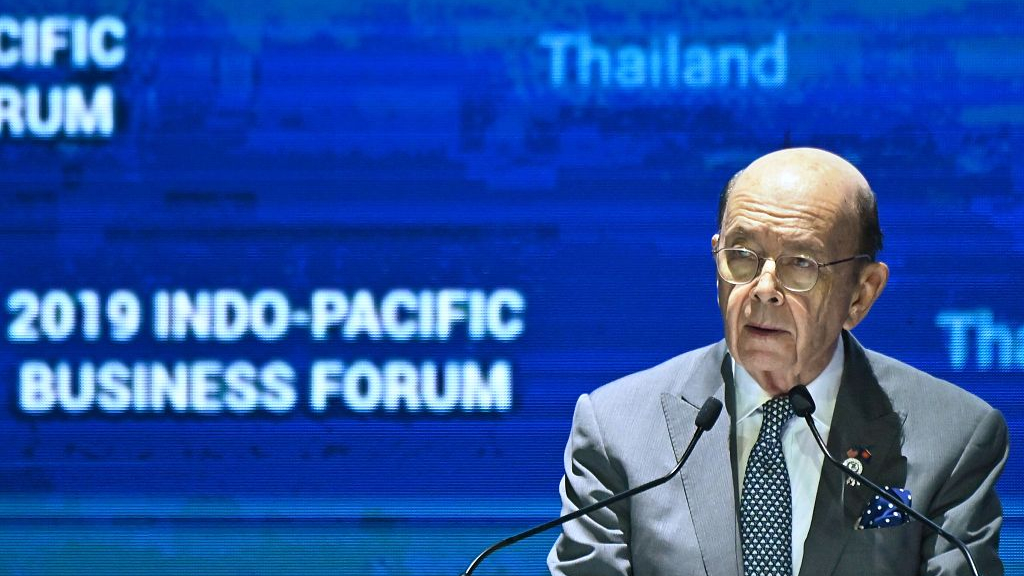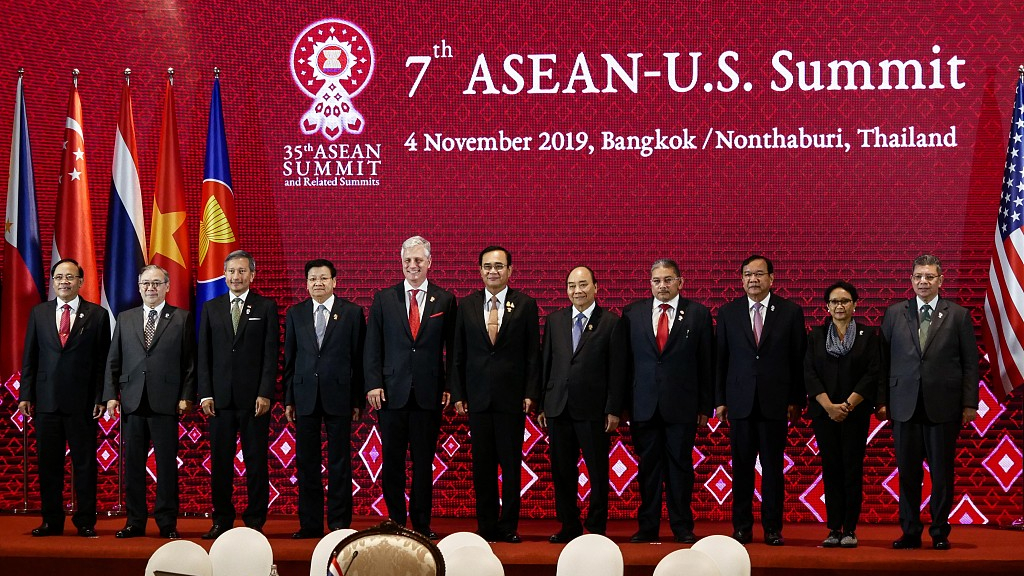
U.S. Secretary of Commerce Wilbur Ross speaks at the Indo-Pacific Business Forum in Bangkok on November 4, 2019, on the sidelines of the 35th Association of Southeast Asian Nations (ASEAN) Summit. /VCG Photo
U.S. Secretary of Commerce Wilbur Ross speaks at the Indo-Pacific Business Forum in Bangkok on November 4, 2019, on the sidelines of the 35th Association of Southeast Asian Nations (ASEAN) Summit. /VCG Photo
Editor's Note: Tom Fowdy is a British political and international relations analyst and a graduate of Durham and Oxford universities. He writes on topics pertaining to China, the DPRK, Britain, and the United States. The article reflects the author's opinions and not necessarily the views of CGTN.
On Monday negotiations for the Regional Comprehensive Economic Partnership (RCEP), a pacific wide trade agreement previously consisting of 16 parties, reached a conclusion in negotiations at a ASEAN summit in Bangkok. Although India would step down from the agreement, the pact will remain significant for bringing together all of ASEAN, China, Japan, South Korea, Australia and New Zealand into a tariff and services free arrangement which is to be legally formalized in February 2020.
Meanwhile, the United States and China are drawing close to a potential agreement themselves titled a "phase one" trade deal, which is posed to de-escalate the trade war between the two countries, nevertheless U.S secretary of Commerce Wilbur Ross who had attended the Bangkok summit in absence of any senior officials, sought to play down and dismiss the regional comprehensive economic partnership as insignificant trade deal, claiming it was "nothing like" TPP.
The secretary's comments are a bit strange, and come across as slightly resentful. The United States have consistently outlined what they describe as a vision for a "free and open Indo-Pacific" which in tandem champions free trade and commerce, but what have they done to achieve this? The Trump administration has in fact brought about the complete opposite effect in the region.
How so? Firstly by withdrawing from TPP, and then waging multiple trade wars and demands against a number of regional parties in the name of "America First." As a completely ironic twist to Wilbur's comments, the RCEP was in fact accelerated by the effects of U.S. trade disruption in the region. Thus, the United States is mocking free trade whilst actually locking itself out of the game due to failure of setting the norms, rules or being leaders at all.

The ASEAN-U.S. Summit receives a down-sized treatment on November 4, 2019, given U.S. President Donald Trump's attitude towards the organization. /VCG Photo
The ASEAN-U.S. Summit receives a down-sized treatment on November 4, 2019, given U.S. President Donald Trump's attitude towards the organization. /VCG Photo
The Trump administration withdrew from the TPP or "transpacific partnership" from his first week in office, to be fair to him he had resolutely committed to do it. Still, it was not well calculated from the U.S. strategic viewpoint. The objective of the agreement, articulated by the Obama administration, was to "write the rules" of trade in the Pacific so that (in his own words) "countries like China do not."
Trump ended it, and in doing so ceded would have been clear leadership in regional commerce. Although several countries rekindled the agreement amongst themselves, without the U.S. it was deemed too small to be a "game changer" as per its original intent.
Trump's intended withdrawal was not a surprise, did he on the other hand offer any new incentives or compromises to buffer the impact of it? Not at all, instead, he poured petrol onto the fire by waging a number of trade disputes against regional countries.
Most dominantly has of course been China, but the president has also pursued a longstanding trade dispute against Japan, only gaining a partial deal, whilst simultaneously slapping huge steel tariffs on Vietnam and quietly making the same demands to Hanoi which it did to Beijing. In the process, the fallout with China has saw a slowdown in most regional countries, hitting exports, imports and reducing GDP growth.
As a result, progress on the RCEP was hastened by a bid amongst Pacific countries to offset the impact of trade disruption to their own economies. This allowed countries even frosty towards China of late, such as Australia and New Zealand, to follow suit. With New Delhi also not following through, largely due to concerns over its own domestic industries, the whole scenario poses a lot of questions for the so called "Indo-Pacific." The onset of Trump's foreign policy has not supplemented the region, but completely forsaken it.
This scenario means in the bigger picture, whilst China is prepared to make a deal with the United States, Beijing will be able to easily mitigate the trade war, uphold its manufacturing strength, establish new markets and thus reduce Washington's leverage over it.
If Trump has, throughout all his trade disputes, sought to re-establish American primacy in trade and manufacturing, he has achieved no such thing. The absence of any U.S. elite officials at the Bangkok summit told its own story that for a nation prioritizing the "Indo-Pacific" at best its strategy is self-defeating. Washington is locked out and has less of a hand over the region's economic future than it did before.
(If you want to contribute and have specific expertise, please contact us at opinions@cgtn.com)